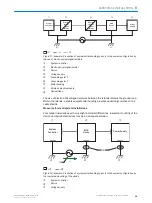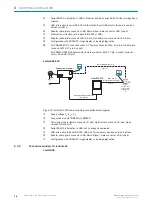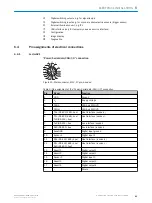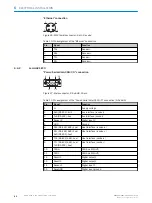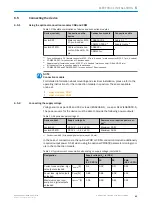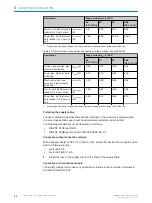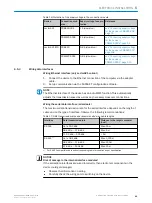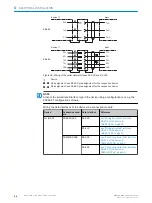
Lector621 ECO
:
The two digital inputs are located at the 15-pin D-Sub-HD male connector of the con‐
necting cable.
Signal
3
3.32K
6.64K
"
§
$
Sensor GND
V
S
2
V
S
V
S
V
in
5
!
PNP sensor
1
GND
GND
Switching input of device
4
GND
V
S
Figure 29: Wiring a digital input
1
Trigger sensor (PNP sensor)
2
Supply voltage V
S
3
Input signal
4
Digital input of the device (“Sensor 1” or “Sensor 2”)
5
Input voltage V
in
!
...
$
For pin assignment, see respective device
Table 18: Characteristic data of the digital inputs “Sensor 1” and “Sensor 2”
Switching behavior
Power to the input starts the assigned function, e.g. start of the
internal reading interval of the device.
Default: active high
Debouncing: 10 ms (standard)
Features
•
Opto-decoupled, reverse polarity protected
•
Can be wired with PNP output of a trigger sensor
Electrical values
The electrical values are identical for all digital inputs of the
device.
Low: V
in
1)
≤ 2 V; I
in
2)
≤ 0.3 mA
High: 6 V ≤ V
in
≤ 30 V; 0.7 mA ≤ I
in
≤ 5 mA
1)
Input Voltage
2)
Input current
Function assignment
NOTE
Assign the functions for the digital inputs in the device using a configuration tool, e.g.
the configuration software SOPAS ET.
Extension: Additional logical digital inputs in the device for physical external digital
inputs on the optional connection module
Thanks to the optional CMC600 parameter cloning module in combination with the CDB
or CDM connection module, the two digital inputs “External input 1” and “External
input 2” are additionally available at the relevant terminals of the connection module.
NOTE
The external digital inputs are software-controlled and therefore do not offer the same
timing precision as physical inputs. They may therefore not be suitable for time-critical
applications.
6
ELECTRICAL INSTALLATION
48
O P E R A T I N G I N S T R U C T I O N S | Lector621
8022502/15NT/2020-02-11 | SICK
Subject to change without notice


